The powerful work hard to operate in the shadows. The Lever’s reporters invest a lot of time and effort digging deep into stories like the one you’ll find below, in order to shine a light on well-hidden corruption. This is difficult and costly. Please consider clicking the button below to become a paid supporting subscriber to The Lever. You’ll get great perks and will be directly financing this critical work. Rock the boat.
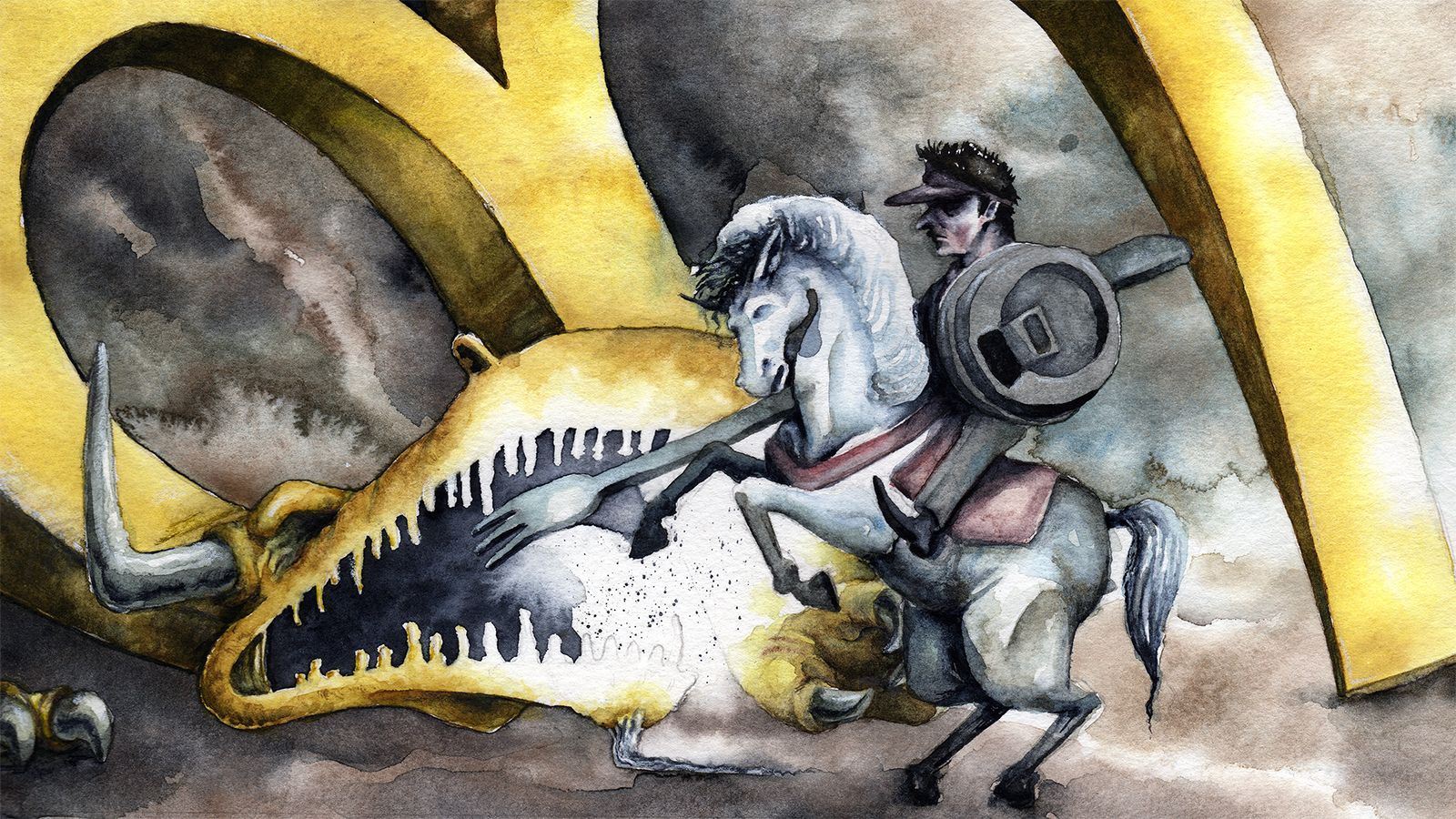 The National Restaurant Association grapples with a worker uprising. (Illustration by Scott Shields) By Julia Rock [View in browser] “Comrades,” said Chappell Phillips, as he grabbed the microphone, “please do not leave the conference. It’s all better from here.” Phillips, an executive at the buffet restaurant chain Golden Corral, stood at a podium in the front of a hotel ballroom in Atlanta, before some one hundred restaurant executives and managers and union avoidance lawyers mingling and sipping weak coffee. Minutes earlier, the government’s top labor watchdog had been standing at the same podium delivering the keynote speech here at the October 2022 summit of the Restaurant Law Center, the legal arm of the National Restaurant Association. Lobbying groups often invite government officials to their conferences to curry favor or gain insight into regulatory developments. But America’s chief enforcer of federal labor law at the National Labor Relations Board (NLRB) had not stuck to the proverbial script. Instead, the agency’s general counsel Jennifer Abruzzo warned audience members that if they fired workers for union organizing, the NLRB would not only reinstate the workers, but also seek full back pay and even public apology letters. 💡 Follow us on Apple News and Google News to make sure you see our stories first, and to help make sure others see our breaking news as well. “I’m not nickel and diming workers,” Abruzzo told the audience, which included lawyers from Fisher Phillips, Jackson Lewis, and Littler Mendelson, three of the biggest union-avoidance law firms in the country. Abruzzo’s candid reminders that the NLRB is a “pro-worker” agency, formed in part to “level the playing field between employers and workers,” contrasted sharply with presentations by other speakers at the Restaurant Legal Summit — the 6th annual conference held by the legal arm of the notorious National Restaurant Association, referred to by critics as the “other NRA.” This year, executives linked to Aramark, Red Lobster, McDonald’s, Auntie Anne’s, Cinnabon, Arby’s, and Dunkin’ Donuts had gathered with management-side employment lawyers to plot ways to beat back a growing threat: a restive workforce demanding higher pay, better working conditions, and, increasingly, union representation. The restaurant industry has long coordinated efforts to suppress labor costs through the NRA, a multimillion-dollar lobbying machine funded both by its restaurant members and by the fees workers pay for required food-safety classes, according to a recent New York Times report. The group has spent its war chest on lobbying campaigns to preserve a subminimum wage for tipped workers — who are disproportionately young, women, and people of color, and far more likely to live in poverty than regular minimum wage workers — and to help block state and federal sick leave proposals and minimum wage increases. But now, restaurant executives are on edge. Union campaigns are suddenly penetrating their industry, which employs about 10 percent of the American workforce and has one of the lowest unionization rates of any sector. Over the past few years, baristas have unionized nearly 280 Starbucks stores in the face of enormous odds, and dozens of other coffee shops and restaurants have followed suit. Presenters at the conference were fixated on this ascendant “workplace democracy,” as Abruzzo has called it, and the agenda touted presentations on “Top 10 Tips for Addressing Social and Political Issues in the Workplace,” and “The Evolving World of Labor Relations: An Organizing Re-Union.” Speakers were prepared to tackle issues from the risks of letting employees wear Black Lives Matter-branded facemasks to how to leverage environmental, social, and corporate governance (ESG) efforts as part of a union avoidance strategy. Abruzzo’s speech had set the stage for an anxious couple of days. It’s why Phillips — the immediate past-chairman of the Restaurant Law Center — was apparently concerned that the NLRB’s general counsel might have hurt its members’ feelings. “Hang in there, don’t despair,” he said to the audience, once he’d regained control of the microphone. “It’s going to get better from here.” “Times Have Changed”“I started out working in the restaurant industry when I was 15 years old, maybe at $3.35 an hour.” A stocky, jovial lawyer was presenting on “wage and hour” issues, the bread and butter of the NRA’s lobbying work, and the audience was giggling at his tales of the good old days in the restaurant industry. The speaker, Steve Miller, is now a partner at the corporate law firm Fisher Phillips, which bills itself as “one of the largest firms in the U.S. representing management in labor, civil rights, employee benefits and immigration law.” His starting wage of $3.35 an hour was the federal minimum wage in 1985 — when Miller was about 15 years old — and is equivalent to more than $9 an hour today, adjusted for inflation, substantially more than the current federal minimum wage of $7.25. “A lot of the things we talk about today, the violations, are a lot of things I personally encountered growing up I really didn’t think twice about,” Miller went on. “But times have changed and you can’t do things that we used to.” He happily recounted how in the old days he was “doing all of this stuff that you’re not supposed to do” as a minor, like “walking around with big knives” and “shoving raw sausage into a meat grinder.” Times may have changed since Miller was a kid wielding blades, but one thing has remained the same: The century-old NRA has been fighting to govern working conditions in restaurants for far longer than Miller has been alive. 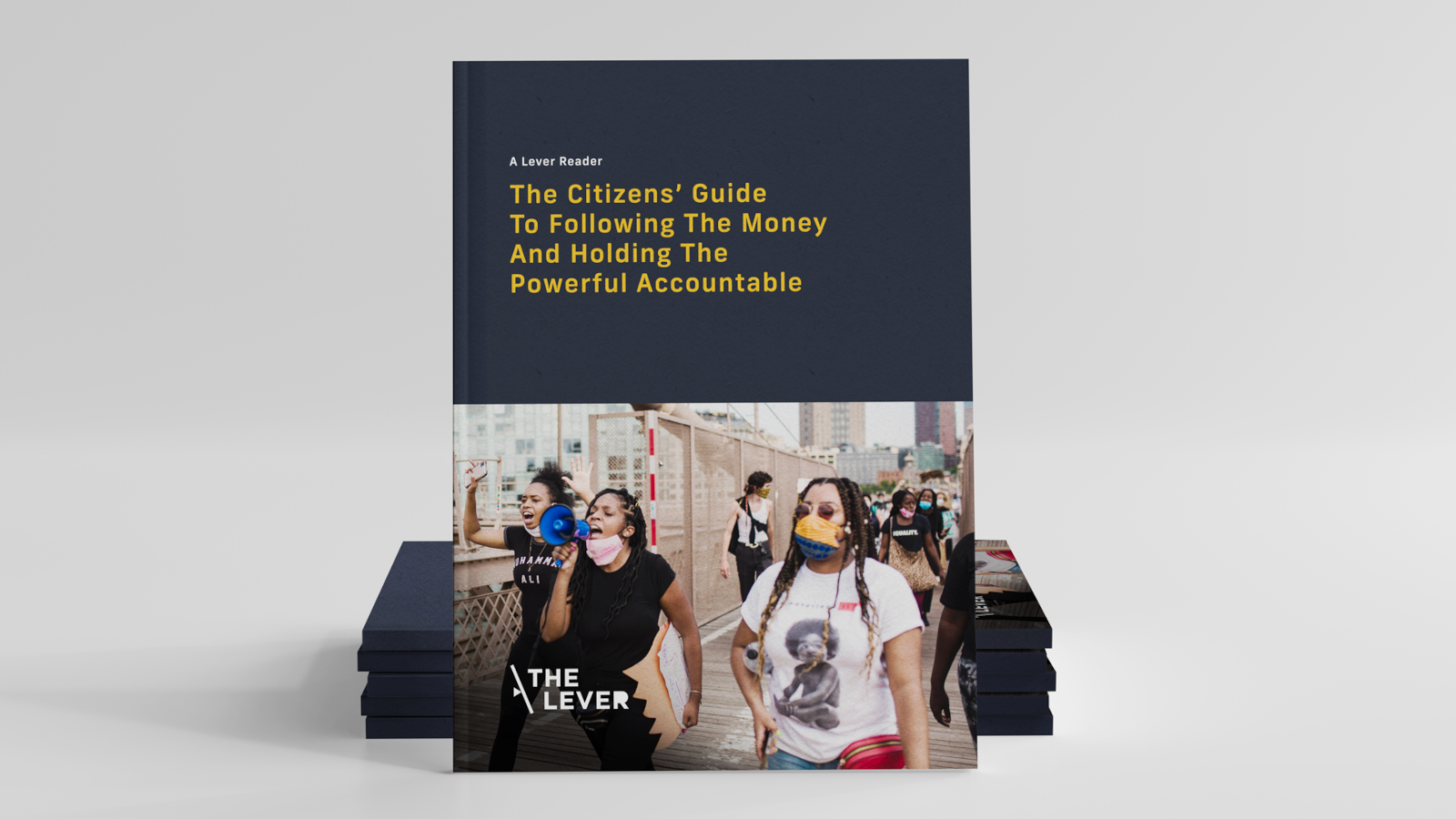 | Learn All Our Investigative Tricks |  | Score a copy of our Citizens’ Guide to Following the Money and Holding the Powerful Accountable, free with a paid subscription. The e-book gives you all the tools and tricks our reporting team uses to scrutinize power. | |
The lobbying group was born during a 1917 restaurant boycott over egg prices. Within a few years, the group was organizing to fight unions in the restaurant industry. It’s largely thanks to the NRA that the federal subminimum wage for tipped workers is still $2.13 an hour, and remains the prevailing subminimum wage in 15 states. When COVID-19 hit the United States in 2020, political battles in the industry intensified as restaurants became even more contentious sites of clashes over public health and workers rights. Restaurant workers had some of the highest COVID death rates in the first two years of the pandemic, as their workplaces were hotbeds for COVID to spread as the NRA and its affiliates lobbied state and local governments to keep restaurants open. Small restaurants closed en masse while large chains, like those represented by the NRA, increased their market share — partially thanks to federal aid packages influenced by the NRA. With its coffers in the hundreds of millions, the NRA and its members now spend huge sums on lobbying at the federal, state, and local levels. In 2021, NRA member Inspire Brands (parent company to chains including Arby’s and Dunkin’ Donuts) took credit for halting an effort that would have raised the minimum wage to $15 an hour nationally and eliminated the subminimum tipped wage. After the first day of the conference, attendees boarded buses to the Inspire Brands headquarters in the Atlanta suburbs for drinks and appetizers. The organization also cultivates relationships with politicians like Sen. Joe Manchin (D-W.Va.) and House Majority Leader Steve Scalise (R-La.), in part by inviting them to speak at its conferences. In the case of Abruzzo’s attendance at this legal summit, it quickly became clear — if it hadn’t been beforehand — that such a cozy relationship was off the table. “Angelo usually makes really good decisions, that was horrible,” Phillips had told the audience after Abruzzo’s keynote, referring to Angelo Armador, executive director of the Restaurant Law Center. Armador told The Lever in an email after the event, “I personally invited NLRB GC Jennifer Abruzzo to come and later urged her to accept our invitation. We even covered her travel costs in accordance with all of her agency's ethics rules and federal laws. I don't recall anyone saying that it was a mistake. To the contrary, we found her presentation educational and thought provoking and hope to see her at future events. I am very glad she accepted the Restaurant Law Center’s invitation.” An NLRB spokesperson confirmed that the Restaurant Law Center reimbursed the agency for Abruzzo’s travel expenses and those of NLRB board member Marvin Kaplan, a Donald Trump appointee who also spoke at the conference. 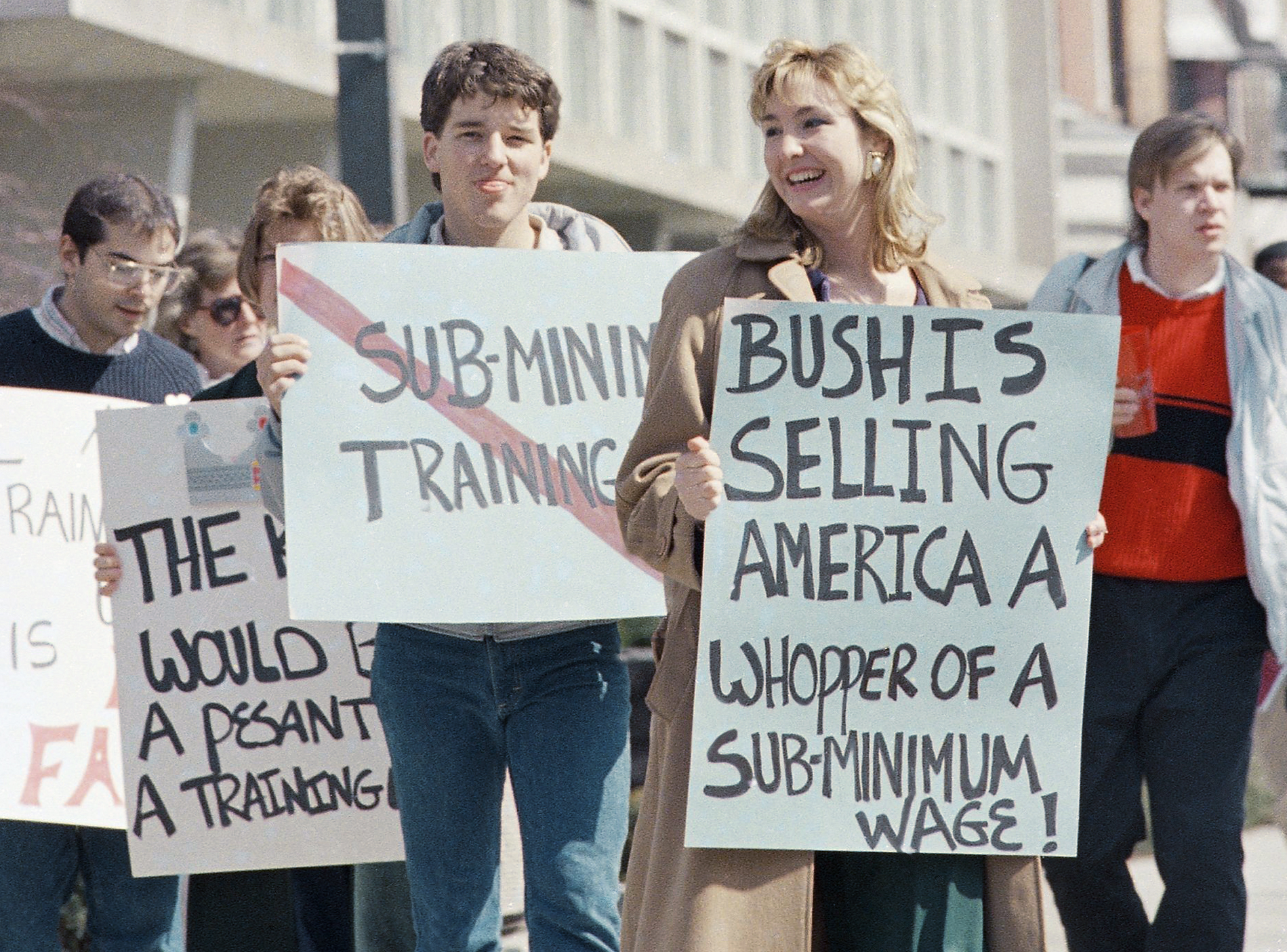 Restaurant workers and their supporters have been fighting for better working conditions for years. Protestors outside a Boston-area Burger King in 1989. (AP Photo/Steven Senne) The Restaurant Law Center is currently suing the Biden administration over a rule regarding how much tipped workers get paid for non-tipped tasks, and the city of New York over a law ending “at-will” employment in the city’s fast food restaurants, instead requiring that fast food workers may only be fired for “just cause.” For wage laws already on the books, the Restaurant Law Center conference was a chance for restaurant managers to figure out how to comply with them, or at least fight lawsuits which alleged they had broken such laws. During his presentation, Miller of Fisher Phillips brought up another threat to low labor costs for restaurants: plaintiff’s attorneys. “Why is wage and hour litigation popular?” asked Miller, referring to class-action lawsuits by workers denied wages. “Well, [the work is] easy, right? [It’s worth] millions and millions of dollars… and it’s easy to find these claims. Plaintiffs’ attorneys jump on this.” As he spoke, Miller displayed a slide with a meme of Dr. Evil from Austin Powers featuring the text “One Hundred Billion Dollars,” as an apparent caricature of a plaintiff’s lawyer. 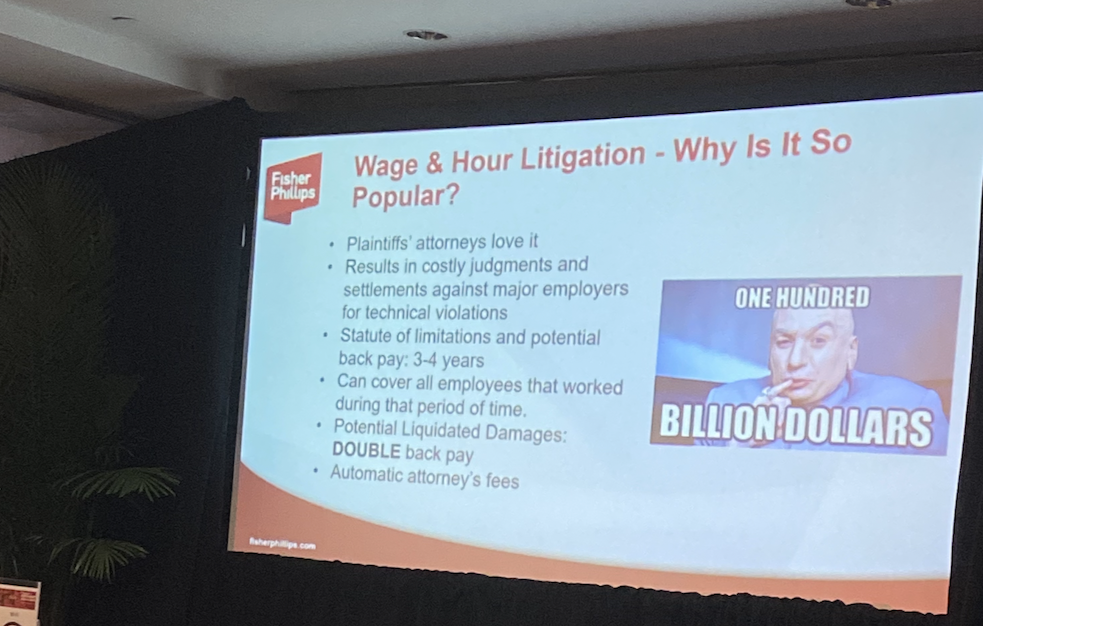 Slide from a presentation by Steve Miller of Fisher Phillips. “There’s a lot of gray area in wage and hour laws,” Miller said, suggesting that restaurant managers had some wiggle room. “So do you go over the top, do you do the ostrich, and stick your head in the sand? You gotta find a healthy mix.” “It’s Scary, Right?”“The New York Times, The Wall Street Journal, every newspaper reports on every union win… when an unfair labor practice charge is filed, when there are challenges to elections,” said Felice Ekelman, a principal at Jackson Lewis, one of the oldest and most infamous union avoidance law firms in the country. “When did this become first page news?” “And guess who’s reading it?” replied Laura Pierson-Scheinberg, one of Ekelman’s Jackson Lewis colleagues, as the two sat across from each other on the main stage of the summit. “My kids. Literally. I have an 18-year-old, my kids are into it.” The two lawyers were discussing a new threat for the restaurant industry: the unexpected rise of union campaigns in workplaces that, for decades, have largely been immune from such organizing efforts.  Police arrest a Burger King employee at an Atlanta fast food protest in 2014. (AP Photo/David Goldman) In December 2021, Starbucks workers in Buffalo voted to unionize, setting off a nationwide organizing campaign with the backing of Workers United, an affiliate of the Service Employees International Union (SEIU). Since then, Starbucks workers have organized nearly 280 stores with Starbucks Workers United while facing a scorched-earth union busting campaign. Jackson Lewis spokesperson Lara Hamm told The Lever that Apple, Amazon and Starbucks are currently clients of the firm, but that “Jackson Lewis was not retained in recent years to represent Starbucks in matters related to union organizing or any matter before the NLRB.” It is nearly impossible to know who is advising companies on union avoidance campaigns because Biden has declined to issue a “persuader rule” requiring employers to disclose when they hire third parties to advise them on union campaigns. Currently, companies are only required to disclose when they’ve hired outside firms that are speaking directly to employees. The firm Littler Mendelson has been representing Starbucks in responding to unfair labor practices charges at the NLRB, per public filings. This current wave of hospitality union organizing has not been enough to halt the decades-long decline of union density in the United States, with new data showing that non-union job growth outpaced the uptick in union membership last year. Still, restaurant executives are on notice. One chain in the northeast, Ekelman told the conference, was following the news of these union campaigns and reached out to her saying, “‘We want to get started, we want to get ahead of the curve.’” “Before, I used to say… ‘[Unionization] isn’t a problem for you in the restaurant industry,’” said Pierson-Scheinberg. But now, she warned, “Kids do not care about paying union dues. Two percent of pay, are you kidding me? Their Netflix costs more. They think it’s a hell of a deal.” The “kids,” she added, are organizing workplaces which would have previously seemed unreachable. “How does Kentucky have a unionized [coffee shop]?” Pierson-Scheinberg asked. “The answer is because it’s a social issue. And it’s done by the employees, not by the unions.” It’s not just the kids. Abruzzo is attempting to use a sorely underfunded NLRB, which has lost 30 percent of its staff since 2010 (although the agency did get a small funding boost in December) to crack down on lawlessness by employers in union elections. The agency has successfully fought to reinstate Starbucks and other workers who were fired for union organizing. “Jennifer Abruzzo is a very competent lawyer, very good at her job,” Pierson-Scheinberg said. “She is just busting heads and changing it all up. And it’s scary, right?” “I Don’t Want To Be Coercive” In 1990, a close North Carolina Senate race threatened to unseat the race-baiting Republican incumbent Jesse Helms. During the election, Michael Jordan, a North Carolina native at the peak of his professional basketball career, declined to weigh in and oppose Helms — because, as Jordan famously told a friend, “Republicans buy sneakers, too.” This anecdote came up at the start of a presentation by Adam Forman, a employment attorney at the corporate firm Epstein Becker Green, and Ariane Panter, Senior Counsel for Global Labor and Employment at McDonald’s, entitled “Top 10 Tips for Addressing Social and Political Issues in the Workplace.” Forman, sporting a sharp combover and a purple bowtie told the tale by way of contrasting today’s corporations — hotbeds of political activity and the frontlines of the culture wars — from workplaces in the 1990s. “We’ve come a long way from that [1990] sentiment where famous people and even corporations tried to stay out of political and social issues under the theory that Republicans buy shoes too, or eat food at your restaurants as well,” Forman explained. The injection of political and social issues into the workplace was a theme at the conference. Abruzzo, for example, had dedicated part of her keynote address to explaining that she intends to broaden the scope of the kinds of workplace behaviors which qualify as “protected concerted activity” — or activity workers can partake in while legally protected against employer retaliation. “Protected concerted activity also is when workers advocate social justice, racial justice, economic justice,” she explained, adding that the NLRB is currently making this legal argument in multiple cases dealing with workers fired for engaging in political activity on the job. One such case involves Whole Foods, which allegedly fired workers for wearing Black Lives Matter insignias to work after protests over the police murder of George Floyd broke out in the summer of 2020, per an NLRB complaint. The federal agency argued that expressing support for BLM amounts to “protected concerted activity,” the legal standard for which is that the issue is relevant to employees’ “mutual aid or protection.” 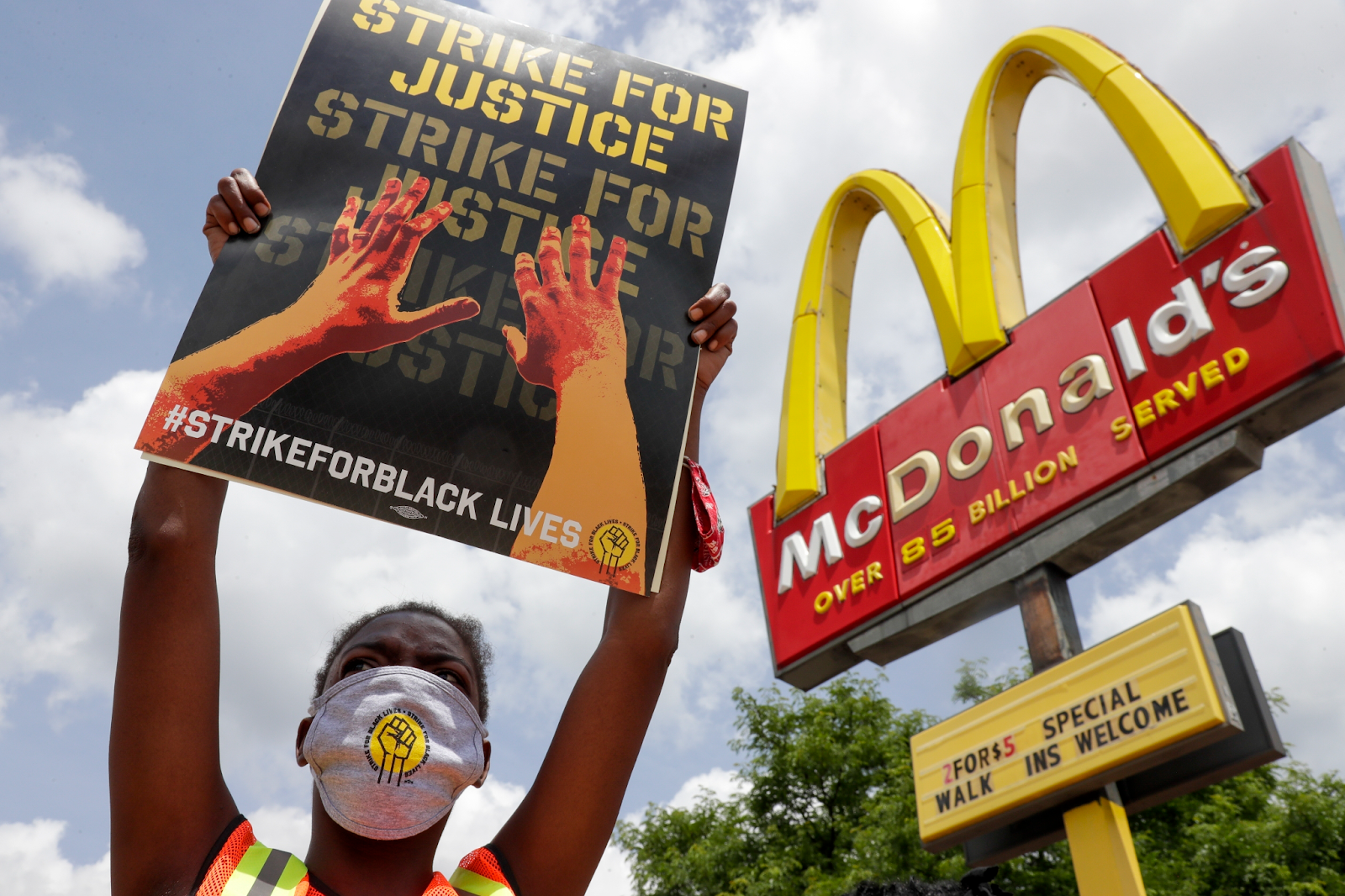 Activists protest systemic racism and economic inequality during the 2020 coronavirus pandemic in Milwaukee. (AP Photo/Morry Gash) Forman is representing Whole Foods in that NLRB case. One of his fellow attorneys on the case argued before an administrative judge that allowing workers to express support for BLM at work could make the workplace more dangerous. Forman made a similar argument during his presentation at the conference, when he explained that allowing employees to wear their political views will provoke an already agitated clientele. “Particularly during COVID, where you have all of this stress and pressure and everybody’s been locked up, and [customers] go into a place, they’re already on edge about PPE and social distancing, and all that,” he said, speaking quickly and excitedly. “Having a big mask in the face, or a big button, that says something that they would spend their life screaming against at the top of their lungs. [Customers are] going to engage… [Employees are] not ready for that kind of interaction, not ready for these crazy customers who are going to start throwing stuff off the table and making a scene.” There might be another explanation for the paranoia. Privately, a Whole Foods executive told managers that allowing workers to wear BLM insignia was “opening the door for union activity.” Whether or not employers are trying to restrict speech because of a concern it could lead to union efforts, Forman advised the audience not to let things get out of hand. “Allowing such communications in the restaurant,” he warned, “could turn that location into a forum for all types of political, social justice, or human rights speech, with its attendant sensitivities.” To the extent that workplaces becoming such “forums” is inevitable, Forman added, “Maybe you try to control the process, you give them a space where they can talk about the issues in a moderated, facilitated way.” He proposed holding “town halls — sorry, voluntary town halls,” to audience laughter, adding, “I don’t want to be coercive.” If employers do want to have official policies limiting worker speech without running afoul of Abruzzo, Forman blithely offered a solution. “If you are worried that one of your prohibitions is too broad, you include a carve-out, a disclaimer that says, ‘Nothing in this policy is meant to intended to prohibit you from engaging your Section 7 rights” — Section 7 referring to the right of workers to engage in protected concerted activity — “or discussing wages, hours, and working conditions, or engaging in conduct for your mutual aid and protection,’ or whatever flowery language you want to use,” he said. “‘We Are Good, Union Is Bad’ — Not Good, Okay?”Jackson Lewis has a well-known and long-standing union avoidance practice. The firm, which raked in more than half a billion dollars in revenue in 2021, has advised large corporations including Ikea and more recently museums, nonprofits, and universities on their anti-union efforts. Its founders Robert Lewis and Louis Jackson got their start in the 1950s at the Labor Relations Associates of Chicago, under the direction of Nathan Shefferman, the “founding father” of the union busting industry. But Jackson Lewis principal Pierson-Scheinberg, who presented on “The Evolving World of Labor Relations: An Organizing Re-Union,” may be learning some of her best lessons in union avoidance from her teenage son. “Funny story,” she told the audience. Her son, a high school senior, was trying to get out of writing a paper, but the only way to get out of it was to bring an outside speaker to talk to his class. “He goes, ‘Mom, I really think you would be cool, and I know you do this everywhere, it would be really cool if you come in. [But] you’re a union buster, so it can’t be you.’” Laughter rang through the audience. She continued: “I said to him, ‘Union busting? I don’t union bust.’ I focus on positive employee relations.” According to Pierson-Scheinberg and her Jackson Lewis colleague on the panel, Ekelman, this current wave of worker organizing requires a different union avoidance strategy. Hurt feelings were to be avoided, and the rhetoric could not be explicit. Like Panter and Forman, they encouraged the audience to provide outlets for employee speech, but in a controlled setting. “The playbook, the organizing training that you may have been having over the years, there’s still relevant pieces to it,” Pierson-Scheinberg explained. “But the most important thing I don’t want you to do is go negative… You have this trophy generation that wants everything light and fluffy. You need to change the mindset to the fact that you are lucky to have them come to work. You are so lucky. Thank you for coming to work today… That’s the way they want to feel, that’s the way they want to be addressed.” Such positivity can help stave off union organizing, Pierson-Scheinberg noted. “The number-one reason for people going to unions is not money, it never has been, ever, it’s always been respect,” she said. 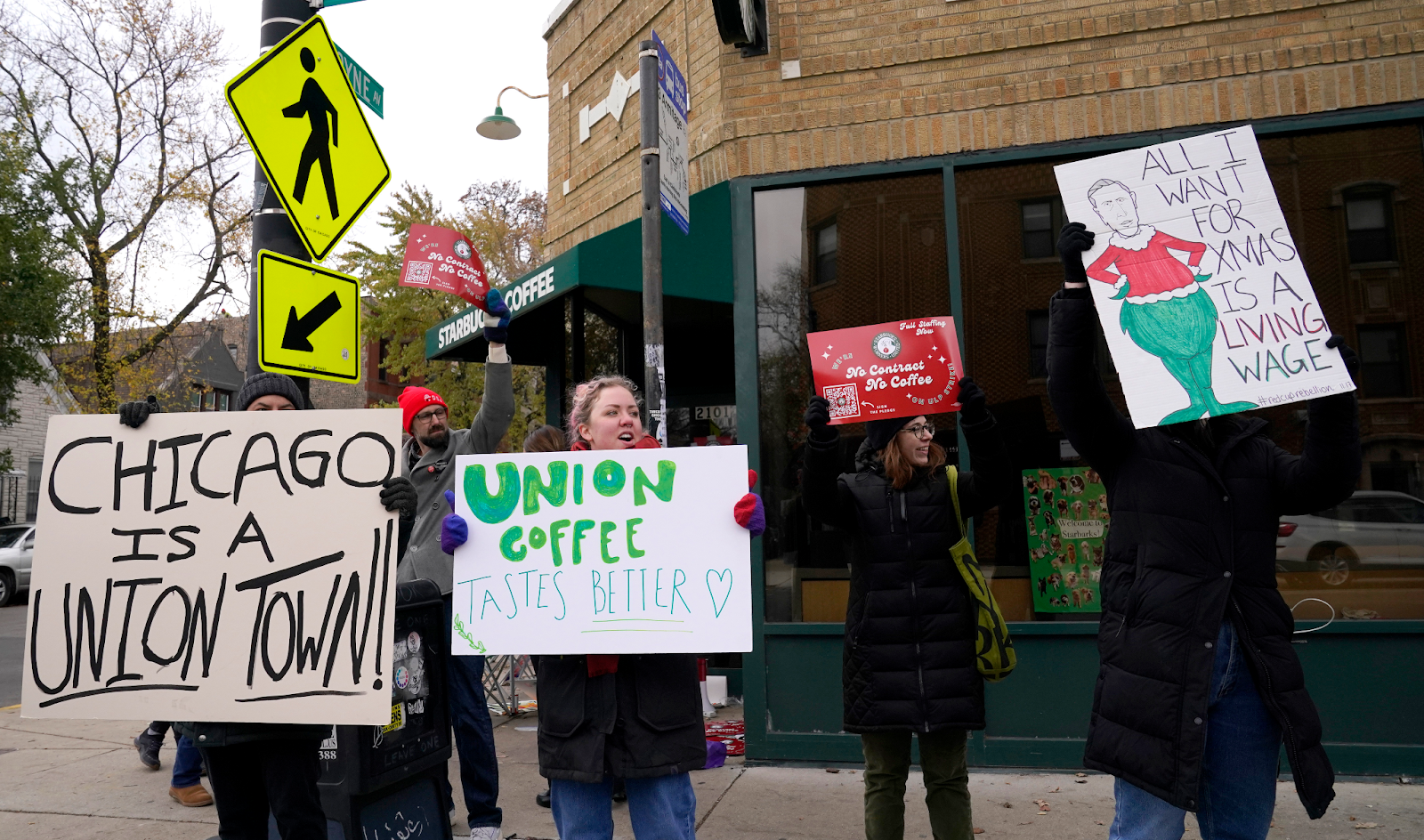 Workers and supporters picket outside a Chicago Starbucks in 2022. (AP Photo/Charles Rex Arbogast) According to the Jackson Lewis lawyers, this “trophy generation” of workers has something in common with another class of people who executives are trying to appease: investors. The increasing fixation among investors on environmental, social, and corporate governance (ESG) and diversity, equity, and inclusion (DEI) is not so different from young workers concerned about social justice, they said. “A lot of those things can double count,” Pierson-Scheinberg said, about “making work fun” and ESG issues. “How many of you are under pressure from your boards or C-suite to get with an ESG program?” Ekelman asked. “This is what everyone is talking about… So ESG can be part of your union avoidance process. By the way, you don’t call your training ‘union avoidance’ training… Positive employee relations, ‘People First’ or whatever, but let’s talk about what it really is.” The lawyers advised the audience that engaging their employees in “ESG” activities might make them less likely to unionize, or at least give companies positive items to talk about in a union avoidance campaign. Messaging on topics like ESG can help companies argue, in the case of a union campaign, that “we have all these programs in place, we are doing all these things that the union is claiming [we] aren’t,” Pierson-Scheinberg explained. As Ekelman noted, the union avoidance language doesn’t have to be at odds with social justice branding: “Your position on unions, if you’re ever asked, should be consistent with your mission statement, should be consistent with your brand, should be something that your customers aren’t going to be upset with you for—” “And cancel you for—” added Pierson-Scheinberg. “And cancel you for,” agreed Ekelman. “Something that if it was on social media, you wouldn’t cringe.” She gave an example: “‘We are good, union is bad’ — not good, okay?” Their suggestion for combining ESG and union avoidance was not to raise workers’ wages or provide better benefits, but instead to give employees opportunities to engage in social issues at work. Like Forman had advised, employee speech couldn’t reasonably — or legally — be stamped out completely, but it could be controlled. The Jackson Lewis lawyers suggested that audience members engage their workers through “ESG programs” like “an employee team that has an impact on sustainability” or “a community committee to talk about community engagement” and all-staff meetings where workers can give updates on what the committees are doing. The Intercept has reported that both Jackson Lewis and Littler Mendelson have encouraged clients to establish “employee resource groups” — affinity groups for people with marginalized identities to discuss workplace issues — as part of a union avoidance strategy. On the topic of “double counting,” Ekelman explained, if a union petition is filed, such regular meetings can easily be turned into a key employer union avoidance tactic: captive audience meetings. Captive audience meetings are held by employers to deliver anti-union messages to workers ahead of a union election. Abruzzo has gone on the attack against such meetings, arguing in a memo that compelling workers to attend them is illegal. At the conference, she reiterated her concerns about such meetings. “The issue for me is not employers being able to express their views, opinions, or arguments about why, in that particular workplace, a union really doesn’t make sense,” Abruzzo had said during her keynote address. “My issue is mandating that employees listen to anti-union rhetoric, when they have the right under Section 7 to refrain from doing so.” She noted that employers “paying for their time” makes employees “economically dependent,” and therefore the meetings are inherently coercive unless attendance is made explicitly voluntary. The Jackson Lewis lawyers assured the audience that for now, captive audience meetings are fine. “Right now, the law is that as long as what you say during a captive audience speech is lawful, you can hold meetings with employees and expect them to attend because you’re paying for their time at the captive audience speech,” Ekelman said. The key, said Ekelman, is acclimating workers to union avoidance tactics. “You should be having — and you don’t have to call it a captive audience speech,” Ekelman said to crowd laughter, “you should be meeting with your employees on a regular basis to talk about things happening in your organization, so that if and when you need to have an old-fashioned captive audience speech where you talk about third parties, you have a history of talking to your employees in these meetings… the captive audience speech is not weird.” 💡 Follow us on Apple News and Google News to make sure you see our stories first, and to help make sure others see our breaking news as well. The tactics, such as “old-fashioned captive audience [speeches],” remain the same, with a slightly different twist to match the moment. But among the people tasked with identifying and stamping out worker upheaval and union activity, there was a strong sense over the course of the conference that a shift was underway. The American labor movement is undoubtedly continuing a decades-long trend of decline, but you wouldn’t have known it listening to corporate lawyers at the Restaurant Legal Summit attempt to convince management that they are still in control. As Forman reminded them, “Lost in this discussion sometimes — and [Abruzzo’s] presentation — it’s your company! You own it.”
Help us spread the word! Please forward this email to family and friends. Was this email forwarded to you? Sign up for free to receive original reporting like this in your inbox every day.
|




